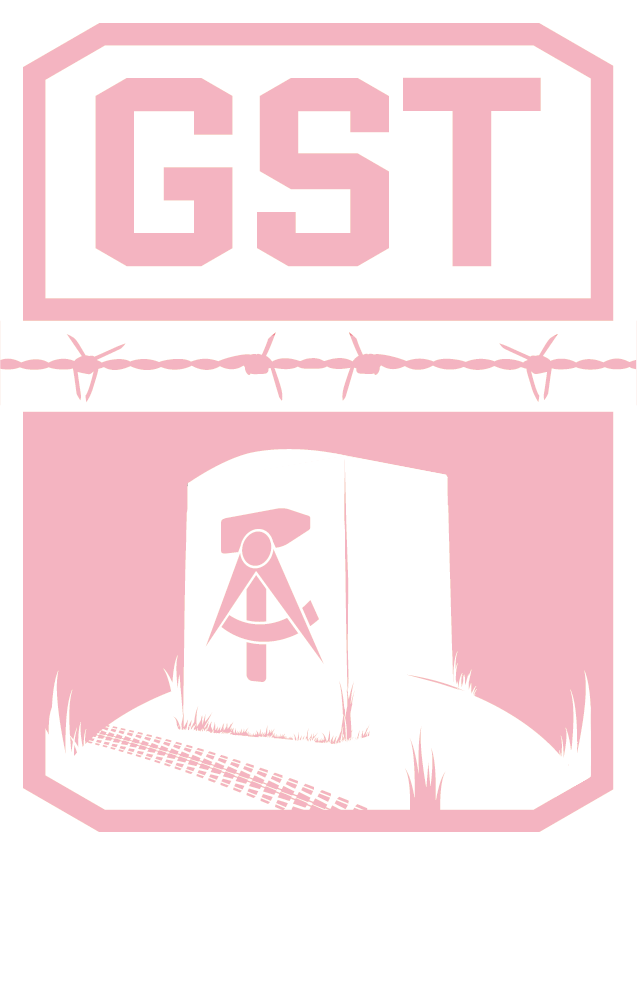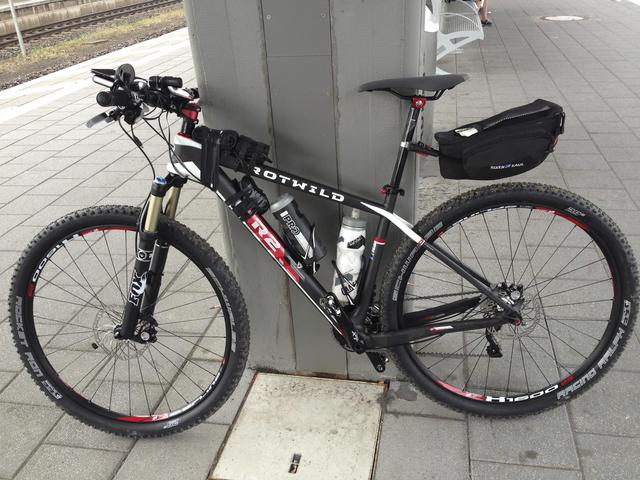Today we start a series of 13 GST-reports of Charles’ GST in 2013 … Great story of a great ride of a great man … enjoy reading and start riding!
A detailed report on my Grenzstein Trophy experience deserves a prelude and here is mine. I first learnt about this 1200 km self-supported ride along the entire length of the former inner-German border in an article written by the Frankfurter Allgemeine Zeitung’s cycling correspondent Hans-Heinrich Pardey and published on 8 July 2012 as a two-page spread in the paper’s Sunday edition. HHP had himself participated in the GST 2012 — albeit in a somewhat leisurely fashion (it took him 22 days to complete) — and his superb reporting convinced me that the GST was one of the most fascinating and demanding MTB self-support rides in Europe. Perhaps it might be called a ‘lite’ equivalent to the 4360 km-long Tour Divide ride along the Rockies, from Banff (Canada) to Antelope Wells in New Mexico (USA). I immediately made up my mind to participate in the GST 2013 — or, to be more honest, I made up my mind to seriously contemplate participating. And one of the first things I did was to read the Tour Divide’s ‘Self Support Ride Codex’ , which in principle also constitutes the rules governing participation in the GST. More — a lot more – -about that later.

Initially I had intended using my cross bike — the same one I had used for Anno Sebbel’s arduous three-day ‘Hamburger Brockensturm’ in May 2013. But after briefly ventilating this idea on Gunnar Fehlau’s Overnighter website and reaping a storm of warnings and recommendations that I should opt for a 29-inch MTB instead — as tried and tested by many of the ‘anciens’ who had participated in the GST in previous years — I changed my mind and bit the bullet. A 29-incher it had to be and, acting on the well-established principle that the number of bicycles a man truly needs is n + 1, n being the number of bikes he currently possesses, at the last minute (well, on Thursday, 13 June — four days before the balloon went up in Priwall) I raided the piggy bank and purchased a featherweight Rotwild R2 hardtail off the shelf at my local bicycle shop in Luxembourg.

Heading back to the wild for the simple life — with a little help from high technology
The only MTB I had been acquainted with prior to the GST was a rigid non-suspension bike with an aluminium frame which I had bought twenty years previously and which I utilised mainly in winter for training and fitness purposes rather than for pleasure. By contrast the Rotwild R2 was a 10 kg ultralight dream and riding it was a completely different experience. The tyres had no inner tubes but Charel — the bike shop manager — assured me that there was a kind of milky foam inside them that would immediately seal off any potential flats.
The front suspension made off-road cycling seem nice and bouncy in comparison with the experiences I had had with my old boneshaker. I also noticed that on the right shoulder of the shock absorber there was a kind of dial whose function was unknown to me – I being too short-sighted to bother reading the letters on it. To my eternal shame, I completely forgot about its existence and did not discover the purpose of the device until about 900 km into the GST.
Wots’ that? — the mysterious dial on my Rotwild’s shock absorber. I discover its function after about 900 km.
Well before the starting date on 17 June a number of birds of ill-omen began to hover over my head.
Firstly, for some mysterious reason I found it impossible to download onto my PC the GST 2013 track which Gunnar had kindly mailed me. I kept on getting the condescending message that ‘Your current security settings do not allow this file to be downloaded’, and although I spend hours trawling through the net in search of a solution it was all to no avail. I could turn my security settings down to zero but my PC would not budge: it seemed there was no way I was ever going to be able to access the file and transfer it to my Garmin 800 satnav.
In desperation I decided to use my iPhone 5 as an emergency fallback, since I had no difficulty in opening the GST file there with the aid of a free GPS app (‘GPX Navigator’) . The downsides of using an iPhone instead of a dedicated satnav became obvious pretty soon, but I truly had no alternative. A last-minute attempt to transfer the track using a Garmin-to-Garmin cable kindly proposed by one of the participants at the group dinner in Travemuende on the eve of the event also failed.
So the iPhone 5 it had to be — a delicate device with all the robustness of a piece of Dresden porcelain and in no way suited for heavy duty activities such as off-pavement cycling. Even worse, an iPhone can run out of juice within two or three hours with a SatNav app activated and the display screen illuminated — what one might call Ruecksprung durch Technik. This meant I had to purchase a rechargeable battery pack (PowerGen) with the equivalent of five iPhone refills and, to be on the safe side, two mini-chargers which accepted disposable AA batteries (PortaPow), for use in an emergency within an already existing emergency. I velcroed all these gadgets onto the Rotwild’s crossbar, since it has a rectangular cross section which is excellent for this purpose.
Secondly, I didn’t get around to purchasing a large, strap-on seatpost bag in good time. Even the best cycle shops do not stock such voluminous items, for the very sensible reason that only about 0.001% of cyclists ever need them — about as many as participate in the GST or similar, long-distance off-road events. If you don’t order one from a niche market supplier well in advance, you will not get one. Thus I was forced to rely on a road bike seatpost bag whose plastic contour clamp quite predictably disintegrated after several hundred miles of exposure to the vibrations caused by the patrol roads’ perforated concrete slabs, by gnarly root paths and stoney passages on river beds.
Will the seatpost bag clamp survive the ordeal of the GST? To ask that question is to answer it.
Thirdly, my obsession with minimalist and ultralight cycling. My self-imposed upper limit was 30 items and 80 kilos (65 kilos of myself, 10 kilos of bike, and 5 kilos of gear, the latter including the clothes I was wearing but not food and drink). Inter alia this meant leaving my sleeping bag behind and relying for insulation on a homemade bivy bag (80g) consisting of one and a half bin liners which I had stuck together with duct tape, in conjunction with a light inflatable air mattress (Thermarest Neoair — 340g). The binliner innovation turned out to be a piece of folly, as I discovered later on during the night of the Big Chill. But at least it was cheap — 80 cents. Had I known in advance, I would have opted for a Gellert survival bag instead (6 euros, 360g).

Besides, instead of taking my rainproof overshoes — and in order to save 200 grams — I packed a roll of gaffer tape, intending to wrap it round my shoes to keep my feet dry in the event of rain. This brainwave unfortunately proved to be another non-starter: when it rained the gaffer tape let the water in, but when the rain stopped it didn’t let the water out.
Such was the state of affairs on Friday, 14 July 2013, when I travelled by train to Luebeck together with my brand new Rotwild. Its virgin ride was the one mile trip from my home to the local railway station.
On the following Sunday I cycled to Travemuende and — as scheduled — met up with the other participants for the pre-GST dinner at the Cafe Luzifer. Several of the participants had taken part in the GST the year before and I picked their brains as much as possible for tips and tricks. Some expressed scepticism about my confidential assertion that — with a bit of luck — any healthy and able-bodied cyclist should be able to complete the trip within eight days.


Charles, I really enjoyed reading your report’s first part and can’t wait for the next one. When I came home after last year’s GST I was listening to all the calls and yours are the ones I probably best remember. Unfortunately I did not have the pleasure to bicycle with you, but Jörg did, who left our group in Vacha. Thank you for writing down your GST story!
Hi Olaf,
Many thanks for the kind words. I well remember Joerg telling me after he’d phoned you on the 27th — just after you had finished — that you had told him that the last 20 km before the Dreilaendereck were hell on earth. I didn’t really believe that anything could be worse than what we’d already been through — but the day after I soon discovered that you were indeed right.
Regards,
Charles